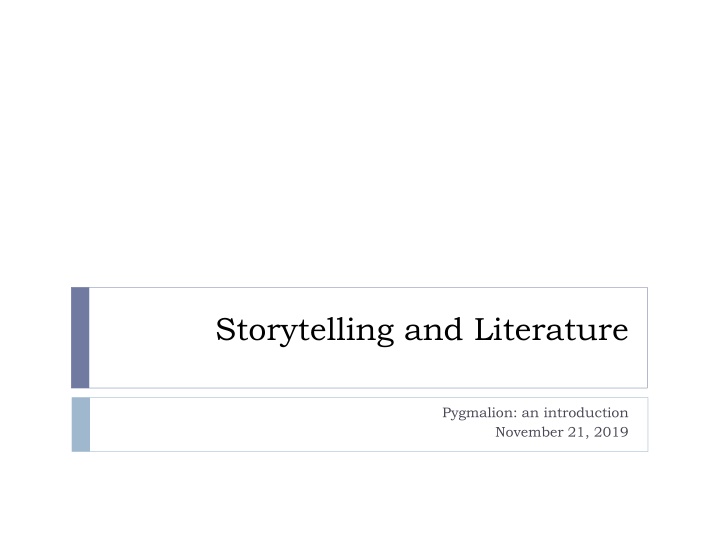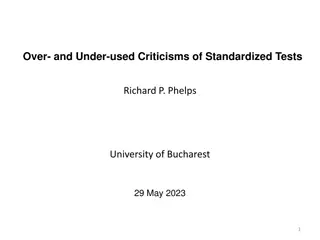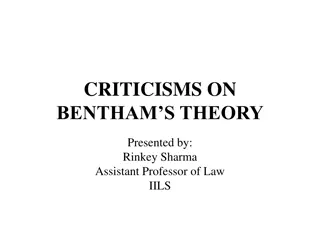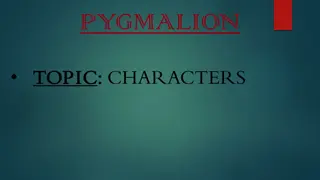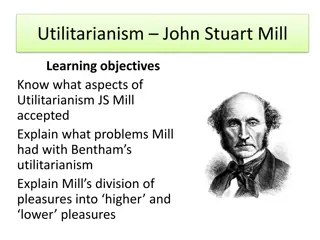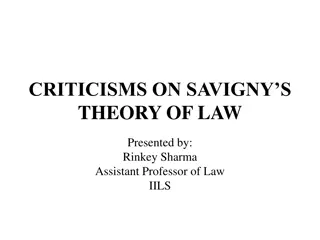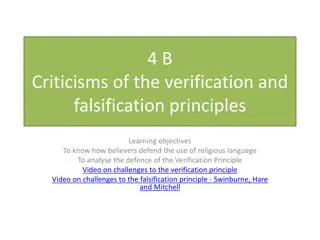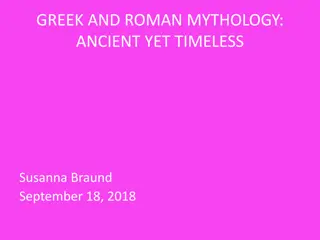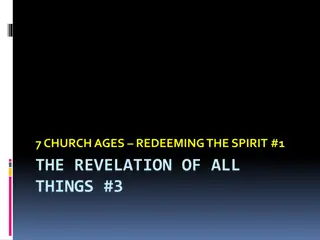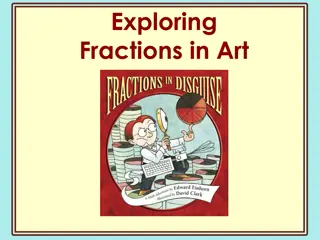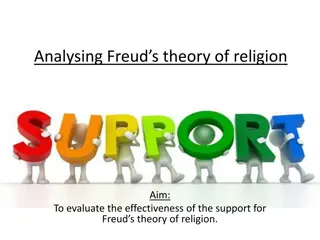Exploring the Pygmalion Story: Art, Love, and Criticisms Through the Ages
The Pygmalion story, originating from Ovid's Metamorphoses, tells of a sculptor who falls in love with his own creation and sees it come to life. This tale has been interpreted and critiqued over time, focusing on themes like the power of art, idolatry, and gender dynamics. From Ovid's portrayal to medieval and Renaissance treatments, the story reflects changing societal values and perceptions of love, art, and devotion.
Download Presentation

Please find below an Image/Link to download the presentation.
The content on the website is provided AS IS for your information and personal use only. It may not be sold, licensed, or shared on other websites without obtaining consent from the author.If you encounter any issues during the download, it is possible that the publisher has removed the file from their server.
You are allowed to download the files provided on this website for personal or commercial use, subject to the condition that they are used lawfully. All files are the property of their respective owners.
The content on the website is provided AS IS for your information and personal use only. It may not be sold, licensed, or shared on other websites without obtaining consent from the author.
E N D
Presentation Transcript
Storytelling and Literature Pygmalion: an introduction November 21, 2019
Ovid, Matamorphosis(10. 243-297) The oldest version of the Pygmalion story a sculptor of Cyprus who turned away in disgust from the local women because of their sexual immorality. Instead he fell in love with a statue of a beautiful woman that he had himself carved from ivory. He courted it as if it were a woman, dressing it in fine clothes, bringing it gifts, even placing it in his bed. Finally in despair he prayed to Venus, and Venus granted his prayer: as he embraced the statue, it softened from stone into flesh and turned into a living woman. Pygmalion married his statue-wife, and they founded a royal dynasty; their grandson was Cinyras, the unfortunate father/grandfather of Adonis.
Characteristics of Ovids Pygmalion focusing the story on the power of art. leaving Pygmalion's relationship with the gods as central the comedy of Pygmalion's sudden descent from high- minded celibacy to infatuation, and of his earnest courtship of his unresponsive stony lady. one of the most potent of male fantasies: a perfectly beautiful woman designed to the lover's specifications and utterly devoted to her creator. unsettling or distasteful: the artist-creator and the sexual politics.
Objections Clement s argument against idolatry: it is wrong to worship the art which is deceptive. Renaissance condemnations of Pygmalion s sin of idolatry: transgressing on the prerogatives of God the creator. Abnobius s criticism of Pygmalion s sexual perversity. For modern readers, objectionable in its portrayal of a woman as entirely passive, literally constructed by the artist s hands and gaze, and brought to life to be his submissive child-lover without even the individuality of a name.
Medieval treatments John Gower: the story as a moral fable for lovers about the need for perseverance. However cold a woman may be, you could win her love eventually if you persevere. William Caxton: a rich lord took a beautiful but ignorant servant-girl and educated her to become a suitable wife for himself. An allegory of class and education, the seed of Shaw s Pygmalion.
Renaissances lack of sympathy An extreme example of the folly of love, and especially of the kind of courtly and platonic love . dotage and idolotry : Protestant writers Pygmalion's devotion to his statue irresistibly suggests pagan idolatry and the supposed Catholic worship of images of the Virgin and the saints. A metaphor for our worship of intellectual idols.
Shakespeares Winters Tale The most sympathetic Renaissance response though not mentioning directly. Dealing with art versus nature : Shakespeare was creating a deliberate counter-version to the puritanical suspicion of art, love, and women which runs through most Renaissance version of Pygmalion.
The heyday of Pygmalion: the late 18thc the early 20thc Pygmalion as the artist-creator The sexual and marital relationship of Pygmalion and Galatea A fable of class and education
The Romantic Artist Frankenstein was a darker version of Pygmalion The artist-creator, a solitary, often tormented, sometimes godlike genius, wrestling with the limitations of his material to create and bring to life a vision of ideal beauty. Rousseau gave the statue a name Galatea for the first time. Rousseau s Pygmalion is a genius in despair over the apparent decay of his creative inspiration.
Victorian Writers Beddoes: Pygmalion s passion is not simply love for the statue, but a violent rebellion of the life-force against the inevitability of death, a kind of spiritual quest for the ideal and the divine. William Morris: focusing on the power of Venus Frederick Tennyson: the most loftily idealistic version. Elizabeth Barrett Browning s Aurora Leigh: an image of the limits of unaided human art. Mary Shelley s Frankenstein: a kind of dark shadow of Pygmalion,a myth embodying the horror rather than the joy of lifeless matter becoming alive.
The Sexual Fable W. S. Gilbert s comedy: Pygmalion is already married. Hence the sudden arrival of the beautiful Galatea, adoringly declaring 'That I am thine - that thou and I are one!', is not a happy ending but the start of a tangle of confusions that starts as farce and ends as rather sour tragicomedy. Galatea is perfectly, comically, good and innocent, with no understanding of civilized institutions like marriage, jealousy, war, hunting, money, class, or lying. Her impact on Pygmalion s respectable bourgeois society is catastrophic, and in the end, to restore order she must return to being a statue.
No Happy Ending in the 20thc Twentieth-century writers have taken a bleak view of the Pygmalion/Galatea love story, finding it hard to see any possibilities of happiness in such an unequal and artificial relationship, deconstructing the male dream-fantasy. Robert Graves s Galatea and Pygmalion and Pygmalion to Galatea : talking the traditional motif of Pygmalion listing the qualities of his ideal woman, but restores the balance of power by making Pygmalion s list a series of requests, to which Galatea graciously consents, sealing the bargain with an equal kiss .
Pygmalion the educator Tobias Smollett s Peregrine Pickle: Peregrine Pickle picks up a beggar-girl on the road and, with some new clothes and a hasty education in polite manners and conversation, passes her off as a lady. The episode is a joke and a piece of practical social criticism, the rebellious and misogynistic Peregrine demonstrating how very shallow are the external accomplishments which separate a fine lady from a beggar. Eventually the (nameless) pupil exposes herself by her 'inveterate habit of swearing', and Peregrine, now bored with the joke, is happy to marry her off to his valet.
Bernard Shaws Pygmalion I the phonetician Henry Higgins, to win a bet, passes off the Cockney flower-girl Eliza Doolittle as a princess merely by teaching her how to speak with an upper-class accent. Shaw, like Smollett, uses the story partly to satirise the English class system and its obsession with proper speech. But, more seriously than Smollett, he also faces the morality of the Pygmalion/Galatea relationship. Higgins has his own kind of idealism: 'you have no idea how frightfully interesting it is to take a human being and change her into a quite different human being by creating a new speech for her. It's filling up the deepest gulf that separates class from class and soul from soul.'
Bernard Shaws Pygmalion II But in his enthusiasm for the experiment- as his mother and housekeeper point out he has given no thought to Eliza as a person, or what will happen to her when the experiment is over and she is stranded in a class limbo, with an upper-class accent and tastes but no income or marketable skills Eliza/ Galatea s transformation to full humanity is not complete until she rebels against the patronizing Higgins and walks out to lead her own independent life. In his epilogue Shaw explains why Eliza finally marries the amiably dim Freddy rather than himself.
